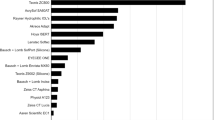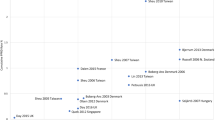Learning Objectives
Upon completion of this activity, participants will be able to:
-
1.
Distinguish the prevalence of intraoperative suprachoroidal hemorrhage (AISH) after cataract surgery.
-
2.
Identify the most significant risk factor for AISH after cataract surgery.
-
3.
Compare different techniques of anesthesia for cataract surgery in the context of their associated risk for AISH.
-
4.
Evaluate other patient factors that can affect the risk for AISH after cataract surgery.
Accreditation Statements
In support of improving patient care, this activity has been planned and implemented by Medscape, LLC and Springer Nature. Medscape, LLC is jointly accredited with commendation by the Accreditation Council for Continuing Medical Education (ACCME), the Accreditation Council for Pharmacy Education (ACPE), and the American Nurses Credentialing Center (ANCC), to provide continuing education for the healthcare team.
Medscape, LLC designates this Journal-based CME activity for a maximum of 1.0 AMA PRA Category 1 Credit(s)™. Physicians should claim only the credit commensurate with the extent of their participation in the activity.
Credit hours
1.0

Release date: May 12, 2023
Expiration date: May 12, 2024
Post-test link: https://www.medscape.org/eye/posttest989929
EDITOR
Sobha Sivaprasad, MD, Editor, Eye
Journal CME author disclosure information
Charles P. Vega has disclosed the following relevant financial relationships: Consultant or advisor for Boehringer Ingelheim Pharmaceuticals, Inc.; GlaxoSmithKline; Johnson & Johnson Pharmaceutical Research & Development, L.L.C.
Abstract
Objective
To establish the incidence of acute intraoperative suprachoroidal haemorrhage (AISH) during cataract surgery and identify the risk factors for this complication.
Methods
Data from the Royal College of Ophthalmologists’ National Ophthalmology Database was analysed. During the 11-year study period, from 01/04/2010 to 31/03/2021, 709 083 operations performed on 498 170 patients from 65 centres were eligible for inclusion.
Results
AISH occurred in 0.03% (204/709 083, approximately 1 in 3 500) of eligible cataract operations performed during the study period. Posterior capsule rupture was the risk factor most strongly associated with AISH (OR: 17.6, 95% CI: 12.4–24.9, p < 0.001). Other ocular risk factors identified were raised intraocular pressure (IOP) preoperatively (OR: 3.7, 95% CI: 2.5–5.5, p < 0.001), glaucoma (OR: 1.7, 95% CI: 1.2–2.4, p = 0.004). Risk increased with age and patients aged over 90 years were at greatest risk (OR: 6.7, 95% CI: 3.5–12.8, p < 0.001). The addition of intracameral anaesthetic when performing surgery under topical anaesthetic appears to be protective (OR: 0.5, 95% CI: 0.3–0.8, p = 0.003), compared to topical anaesthetic alone. There was a 16-fold increase in the incidence of vision loss when AISH occurred.
Conclusions
The risk of AISH during modern cataract surgery is approximately 1 in 3 500 and is associated with a significant increase in the risk of vision loss should it occur. Posterior capsule rupture is the risk factor most strongly associated with AISH. Preoperative IOP control is a modifiable risk factor. The use of intracameral anaesthesia may reduce the risk of AISH.
This is a preview of subscription content, access via your institution
Access options
Subscribe to this journal
Receive 18 print issues and online access
$259.00 per year
only $14.39 per issue
Buy this article
- Purchase on Springer Link
- Instant access to full article PDF
Prices may be subject to local taxes which are calculated during checkout


Similar content being viewed by others
References
Eriksson A, Koranyi G, Seregard S, Philipson B. Risk of acute suprachoroidal hemorrhage with phacoemulsification. J Cataract Refract Surg. 1998;24:793–800.
Beatty S, Lotery A, Kent D, O’Driscoll A, Kilmartin DJ, Wallace D, et al. Acute intraoperative suprachoroidal haemorrhage in ocular surgery. Eye. 1998;12:815–20.
Ling R, Cole M, James C, Kamalarajah S, Foot B, Shaw S. Suprachoroidal haemorrhage complicating cataract surgery in the UK: epidemiology, clinical features, management, and outcomes. Br J Ophthalmol. 2004;88:478–80.
Manschot WA. The pathology of expulsive hemorrhage. Am J Ophthalmol. 1955;40:15–24.
Wolter JR, Garfinkel RA. Ciliochoroidal effusion as precursor of suprachoroidal hemorrhage: a pathologic study. Ophthalmic Surg. 1988;19:344–9.
Reynolds MG, Haimovici R, Flynn HW, DiBernardo C, Byrne SF, Feuer W. Suprachoroidal hemorrhage. Clinical features and results of secondary surgical management. Ophthalmology. 1993;100:460–5.
Ling R, Kamalarajah S, Cole M, James C, Shaw S. Suprachoroidal haemorrhage complicating cataract surgery in the UK: a case control study of risk factors. Br J Ophthalmol. 2004;88:474–7.
Speaker MG, Guerriero PN, Met JA, Coad CT, Berger A, Marmor M. A case-control study of risk factors for intraoperative suprachoroidal expulsive hemorrhage. Ophthalmology. 1991;98:202–10.
Davison JA. Acute intraoperative suprachoroidal hemorrhage in capsular bag phacoemulsification. J Cataract Refract Surg. 1993;19:534–7.
Afzal S, Zaidi STR, Merchant HA, Babar Z-U-D, Hasan SS. Prescribing trends of oral anticoagulants in England over the last decade: a focus on new and old drugs and adverse events reporting. J Thromb Thrombolysis. 2021;52:646–53.
Clinical Data Sets. The Royal College of Ophthalmologists. https://www.rcophth.ac.uk/standards-and-guidance/audit-and-data/clinical-data-sets/. Accessed 5 July 2022.
Davison JA. Acute intraoperative suprachoroidal hemorrhage in extracapsular cataract surgery. J Cataract Refract Surg. 1986;12:606–22.
Knox FA, Johnston PB. Spontaneous suprachoroidal haemorrhage in a patient with age-related macular degeneration on excessive anticoagulation therapy. Eye. 2002;16:669–70.
Akkan Aydogmus FS, Serdar K, Kalayci D, Çelik A. Spontaneous Suprachoroidal Hemorrhage Associated with Iatrogenic Coagulopathy. Retinal Cases Brief Rep. 2019;13:174–5.
Chandra A, Xing W, Kadhim MR, Williamson TH. Suprachoroidal hemorrhage in pars plana vitrectomy: risk factors and outcomes over 10 years. Ophthalmology. 2014;121:311–7.
Benzimra JD, Johnston RL, Jaycock P, Galloway PH, Lambert G, Chung AKK, et al. The Cataract National Dataset electronic multicentre audit of 55,567 operations: antiplatelet and anticoagulant medications. Eye. 2009;23:10–6.
Antithrombotic Trialists’ (ATT) Collaboration, Baigent C, Blackwell L, Collins R, Emberson J, Godwin J, et al. Aspirin in the primary and secondary prevention of vascular disease: collaborative meta-analysis of individual participant data from randomised trials. Lancet. 2009;373:1849–60.
Raber I, McCarthy CP, Vaduganathan M, Bhatt DL, Wood DA, Cleland JGF, et al. The rise and fall of aspirin in the primary prevention of cardiovascular disease. Lancet. 2019;393:2155–67.
Cao J, McLeod S, Merges CA, Lutty GA. Choriocapillaris degeneration and related pathologic changes in human diabetic eyes. Arch Ophthalmol. 1998;116:589–97.
Kim M, Choi SY, Park Y-H. Quantitative analysis of retinal and choroidal microvascular changes in patients with diabetes. Sci Rep. 2018;8:12146.
Russell JF, Zhou H, Shi Y, Shen M, Gregori G, Feuer WJ, et al. Longitudinal Analysis of Diabetic Choroidopathy in Proliferative Diabetic Retinopathy Treated with Panretinal Photocoagulation using Widefield Swept-Source Optical Coherence Tomography. Retina. 2022;42:417–25.
Samuels B. Postoperative Nonexpulsive Subchoroidal Hemorrhage. Arch Ophthalmol. 1931;6:840–51.
Mo B, Li S-F, Liu Y, Zhou J, Wang S-L, Shi X-Y. Suprachoroidal hemorrhage associated with pars plana vitrectomy. BMC Ophthalmol. 2021;21:295.
Day AC, Norridge CFE, Donachie PHJ, Barnes B, Sparrow JM. Royal College of Ophthalmologists’ National Ophthalmology Database study of cataract surgery: report 8, cohort analysis of the relationship between intraoperative complications of cataract surgery and axial length. BMJ Open. 2022;12:e053560.
Haynes JH, Payne JW, Green WR. Clinicopathologic study of eyes obtained postmortem from a patient 6 and 2 years after operative choroidal hemorrhage. Ophthalmic Surg. 1987;18:667–71.
Stevens J, Giubilei M, Lanigan L. Hykin P. Sub-Tenon, Retrobulbar and Peribulbar Local Anaesthesia: The Effect Upon Intraocular Pressure. Eur J Implant Refractive Surg. 1993;5:25–8.
Minakaran N, Ezra DG, Allan BD. Topical anaesthesia plus intracameral lidocaine versus topical anaesthesia alone for phacoemulsification cataract surgery in adults. Cochrane Database Syst Rev. 2020;7:CD005276.
Takayama J, Mayama C, Mishima A, Nagahara M, Tomidokoro A, Araie M. Topical phenylephrine decreases blood velocity in the optic nerve head and increases resistive index in the retinal arteries. Eye. 2009;23:827–34.
Gupta A, Ionides A. Does acute suprachoroidal haemorrhage during phacoemulsification cataract surgery need surgical treatment? Graefes Arch Clin Exp Ophthalmol. 2022;260:3395–6.
Qureshi A, Jalil A, Sousa DC, Patton N, Dhawahir-Scala F, Charles SJ, et al. Outcomes of suprachoroidal haemorrhage drainage with and without vitrectomy: a 10-year study. Eye 2021;35:1879–85.
Blumenthal M, Grinbaum A, Assia EI. Preventing expulsive hemorrhage using an anterior chamber maintainer to eliminate hypotony. J Cataract Refract Surg. 1997;23:476–9.
Acknowledgements
It is with gratitude that we remember our friend and colleague Robert Johnston, who sadly died in September 2016. Without his inspirational vision, determination and career-long commitment to quality improvement in ophthalmology this work would not have been possible. We acknowledge the support of the hospitals that participated in this National Ophthalmology Database Audit study and thank our medical and non-medical colleagues for the considerable time and effort devoted to data collection.
Funding
The National Cataract Audit is currently funded through participation fees from centres as well as unrestricted financial contributions from Alcon and Bausch + Lomb.
Author information
Authors and Affiliations
Contributions
All authors participated in initial discussions regarding study design and definitions. All authors reviewed initial drafts and approved final manuscript. SS and MHG-G prepared first draft (MHGG methods and results; SS intro and discussion). PD collaborated with MHGG for the statistical analysis and PD also is responsible for source database. JB oversaw manuscript preparation commenting on interim drafts.
Corresponding author
Ethics declarations
Competing interests
The authors declare no competing interests.
Additional information
Publisher’s note Springer Nature remains neutral with regard to jurisdictional claims in published maps and institutional affiliations.
Supplementary information
Rights and permissions
Springer Nature or its licensor (e.g. a society or other partner) holds exclusive rights to this article under a publishing agreement with the author(s) or other rightsholder(s); author self-archiving of the accepted manuscript version of this article is solely governed by the terms of such publishing agreement and applicable law.
About this article
Cite this article
Stewart, S., Gruszka-Goh, M.H., Neo, Y.N. et al. The Royal College of Ophthalmologists’ National Ophthalmology Database Study of Cataract Surgery: Report 12, Risk factors for suprachoroidal haemorrhage during cataract surgery. Eye 37, 1778–1787 (2023). https://doi.org/10.1038/s41433-023-02514-y
Received:
Revised:
Accepted:
Published:
Issue Date:
DOI: https://doi.org/10.1038/s41433-023-02514-y
This article is cited by
-
The Royal College of Ophthalmologists’ National ophthalmology database study of cataract surgery: Report 14, cohort analysis – the impact of CapsuleGuard® utilisation on cataract surgery posterior capsule rupture rates
Eye (2024)
-
Risk factors for suprachoroidal haemorrhage during cataract surgery
Eye (2024)



